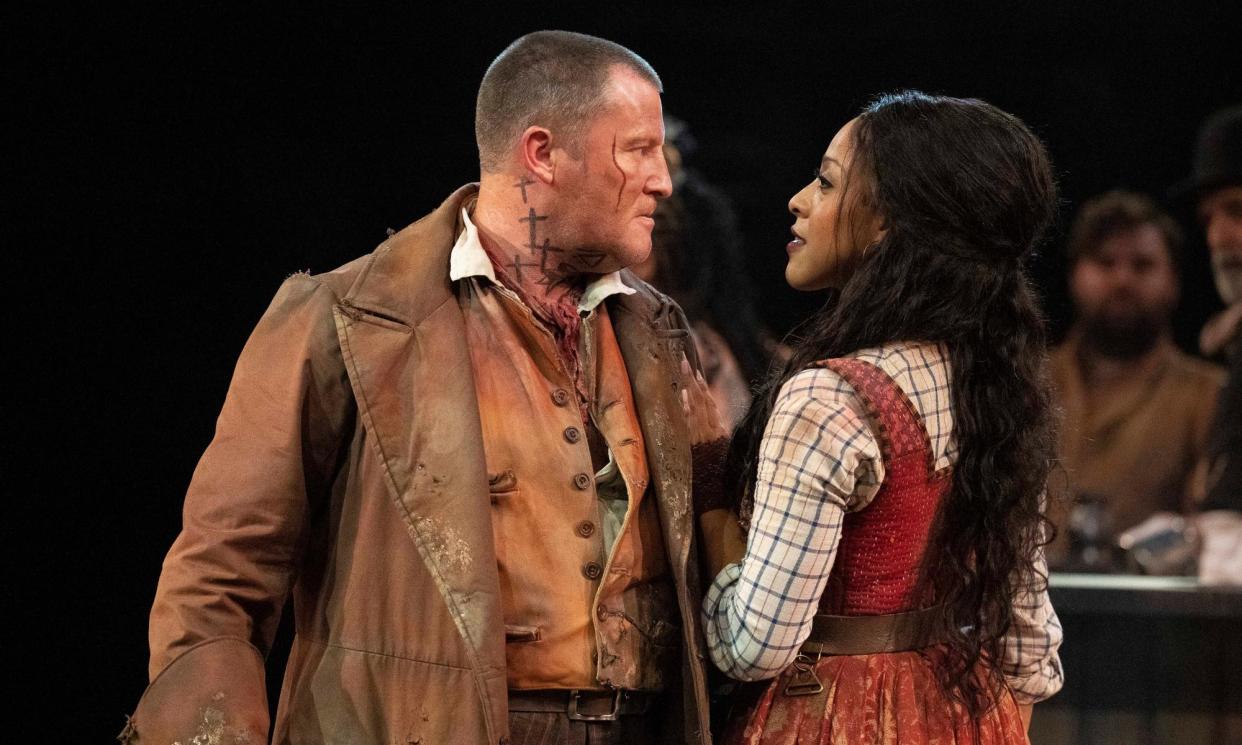From exhilarating Oliver! to a mardy Beast in the east – three of the best Christmas family shows

Oliver!, Lionel Bart’s adaptation of Charles Dickens’s 1838 novel, has been a stage favourite since its first appearance in 1960. It’s incredible to think that Bart was only 30 when he wrote the lyrics, music and book. Though maybe not, given the buoyant energy of the piece, and its powerful sense of the bright possibilities of life that stretch before a child, contrasted with the crushing realities that canker expectations.
With the gentlest of touches, James Brining’s exuberant production at Leeds Playhouse striates light and dark, dancing us between attracting-repelling counterpoints of good and bad. The orphan Oliver (captivating Theo Wake, on the night I was there) is innocence incarnate in the den of boy thieves run by Fagin (nimble Steve Furst). Oliver’s polar opposite is the terrifying villain Bill Sikes (blood-chillingly convincing Chris Bennett). Or is he? Is Sikes the fallen angel Oliver could have become if chance had not united him with his prosperous grandfather?
Brining has transformed the Playhouse stage into the round, which, coupled with Colin Richmond’s design of ladders and intersecting gantries, allows the action to play thrillingly on several levels. Guy Hoare’s lighting now beams these into brightness, now scuds with shadows. Just as there is no single perspective from which the action can best be viewed, so there is no one position from which the main characters can be finally judged; they, too, are multilayered, positive and negative. Complexities are intricately expressed through the late William David Brohn’s musical arrangements and embodied in Lucy Hind’s choreography, deftly manoeuvring us along a taut emotional tightrope.
Our moral compass is set by Oliver and by Nancy. Each is motivated by a belief in the power of love, the former from a position of unknowing, the latter despite painful experience. The actors both seize their moments, opening up for us a clear, precise view of their character’s inner self without sentimentality or self-pity. Oliver’s Where Is Love? becomes an active search, the question addressed to ghostly figures in the undertaker’s workshop. Jenny Fitzpatrick’s Nancy delivers As Long as He Needs Me with a visceral power that compels us to believe not only in the depth of her love for Sikes, but that the villain must harbour a shred of goodness to deserve it.
Dickens’s robust relish for life, its energy and argy-bargy, is delivered with verve by Brining’s well-rounded, well-balanced cast, including Noah Walton’s watchful Artful Dodger (on the night I was there), rumbling beadle Mr Bumble (Minal Patel), gin-pouring siren Widow Corney (Rosie Ede) and upright grandfather Mr Brownlow (Simon Green). All in all, who could ask for more?
Similarly satisfying, though a dish of a very different kind, is Beauty and the Beast at Scarborough’s Stephen Joseph theatre. Nick Lane’s adaptation takes northern liberties with the original 18th-century story by Madame LePrince de Beaumont. The action is set in the fictional seaside town of Scarbolopolis, ruled by the wicked Lady Maloria (black-clad and cackling Annie Kirkman, roundly booed for insulting characters and audience alike), who has made a desperate bargain with a sea monster. Every “Beastmas” she must feed it a huge helping of fear, extracted from the townsfolk through terror tactics.
These facts are unknown to the chirpy, tune-trilling trio who arrive to set up a Christmas gift shop: Nan (bustling Amy Drake), Dad (cheerful Charlie Ryan) and Rosabelle (intrepid Kiara Nicole Pillai). When Dad sets off to collect a delayed delivery, Lady Maloria sees her chance to inject fear into their lives, aided by the assistant she calls Bumtrouser (“It’s pronounced Baümtruser!” he corrects, uselessly).
Helen Coyston’s minimal set is used to maximum effect in this theatre in the round. Lighting, sound and music (Mark “Tigger” Johnson and Simon Slater, respectively) work magical mood and scene changes. Tricked by Maloria, Dad gets lost in a wood (tripping through the rows of a darkened auditorium with only a torch and audience suggestions to guide him, while wolf howls hasten him along the way). He ends up trapped in a crumbling castle with a big, scary Beast (Oliver Mawdsley) and the statues of his forgotten ancestors. Rosie comes to the rescue – of parent and, ultimately, of the “proper mardy” Beast.
Lane and director Paul Robinson are long-term collaborators; they know how to tell a satisfying story and cue audience involvement without egging on or forcing. Their multiple role playing, all-singing and dancing actors (choreography by Stephanie Dattani) create engaging characters and ad-lib with aplomb (ditto audience). Sheer festive fun.
Children skipped from Edinburgh’s Royal Lyceum at the close of The Snow Queen, singing the curtain call reprise, A Horse with a Horn, signature number of Hamish the Unicorn (Richard Conlon, making cringe-worthy, old-fashioned campness engaging; composer Finn Anderson). Writer Morna Young relocates Hans Christian Andersen’s celebration of love and friendship to Scotland and interweaves it with Scottish myths, compellingly introduced by Wendy Seager, who plays Granny May.
In terms of development, scene by scene, it’s a bumpy ride between vivid incidents (direction by Cora Bissett). Notable elements include Emily James’s picturesque set; shadow play of trolls fighting; Samuel Pashby’s Corbie crash-landing; the garden of talking flowers; a sword fight between Rosie Graham’s Gerda and Naomi Stirrat’s Senga; the reunion between Gerda and Kei (Sebastian Lim-Seet); and the defeat of the Snow Queen (Claire Dargo).
Star ratings (out of five)
Oliver! ★★★★★
Beauty and the Beast ★★★★
The Snow Queen ★★★


